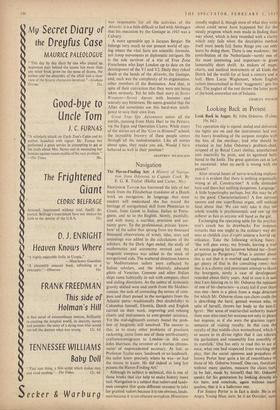Navigation .
The Haven-Finding Art: A History. of Naviga- tion from Odysseus to Captain Cook. By E. G. R. Taylor. (Hollis and Carter, 30s.) PROFESSOR TAYLOR has borrowed the title of her book from the Elizabethan translator of a Dutch work on navigation. In language that most readers will understand she has traced the heritage of navigational skill from Phoenician to Greek, from Greek to Italian, Italian to Portu- guese, and so to the English. Slowly, painfully, and with many a sacrifice, precision and cer- tainty grew. To ,the professional, private 'know- how' of the sailor that sprang from ten thousand thousand observations of winds, tides, stars and soundings was added in the calculations of the scholars. As the Dark Ages ended, the study of mathematics and astronomy revived and the magnetic compass was added to the stock of navigational aids. The scattered directions known to: Mediterranean sailors were collected by Italian scholars, and the relatively educated pilots of Venetian, Genoese and other Italian ships came 'habitually to sail with compass, chart and .sailing directions. As the centre of economic 'gravity shifted west and north from the Mediter- ranean, the task of correcting the errors of com- pass and chart passed to the navigators from the Atlantic ports—traditionally (but doubtfully) to Columbus himself. Flemish, Dutch and English carried on their work, improving and refining charts and instruments to ever-greater accuracy. Yet the mid-eighteenth century found the prob- lem of longitude still unsolved. The answer to this, as to many other problems of precision reckoning, came from one of those north-country craftsmen-emigrants to London—in this case John Harrison, the inventor of a marine chrono- meter of unprecedented accuracy. At last, as Professor Taylor says, 'landmark or no landmark, the sailor knew precisely where he was—or had the means to know. Re did indeed at long last possess the Haven-Finding Art.'
Although its subject is technical, this is one. of those books that can help to make history more real. Navigation is a subject that sailors and lands- men conspire (for quite different reasons) to take for granted: sailors because it is too obvious, lands- men because it is too obscure to explain. Historians usually neglect it, though most of what they writ( about could never have happened but for the steady progress which men made in finding theit way about, which is here recorded with a clarity which only fails when the descriptive method itself must needs fail. Some things you can only learn by doing them, There is one weakness: the contribution of the Netherlands—surely one of the most interesting and important—is given lamentably short shrift. As makers of maps charts, and nautical instruments of all kinds the Dutch led the world for at least a century and a half, Here Lucas Waghenaer, whom English sailors immortalised in their 'waggoners,' gets his due, The neglect of the rest throws the latter parts of the book somewhat out of balance.
CHARLES WILSON


































 Previous page
Previous page